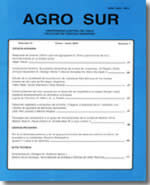Effect of resting period on the quality of five forage grasses and its prediction by near infrared reflectance spectroscopy (NIRS)
Main Article Content
Abstract
The aim of this work was to estímate dry matter accretion, plant height and chemical composition in terms of crude protein (PB), neutral detergent fiber (FDN) acid detergent fiber (FDA), metabolizable energy (EM) and total ashes (CT), of five forage grasses: Bromus valdivianus, Arrhenatherum elatius, ssp bulbosus, Dactylis glomerata, Holcus lanatus and Agrostis capillaris, subjected to four resting periods (from 30 up to 122 days). The feasibility of predicting chemical composition by near infrared reflectance spectroscopy (NIRS) was also evaluated by means of the coefficient of deternination (1-VR) and standard error (SECV) of cross validation. Resting periods explained an advance in plant maturity. A capillaris and B. valdivianus were late and early maturing species respectively, in comparison to other grasses. DM production increased up to the third period (91 d) decreasing afterwards. The highest variation (P<0.05) among species in terms of DM production and plant height was shown in the third period. PB, EM and CT contents decreased from the first to the third resting period, remaining constant thereafter. An inverse trend was shown by FDN and FDA, with increasing values up to the third period, maintaining their values thereafter. Each resting day caused a reduction in PB, EM and CT, of 1.44 g, 0.91 Mcal and 0.42 g per kg DM, respectively and an increase in FDN and FDA in 2.08 and 1.84 g per kg DM, respectively. A good precision was attained with NIRS calibrations to predict composition. Best equations showed values for 1-VR and SECV of 0.97 and 1 for PB; 0.91 and 2.54 for FDN; 0.98 and 1.06 for FDA; 0.87 and 1.14 for EM; and 0.86 and 0.61 for CT, respectively.

